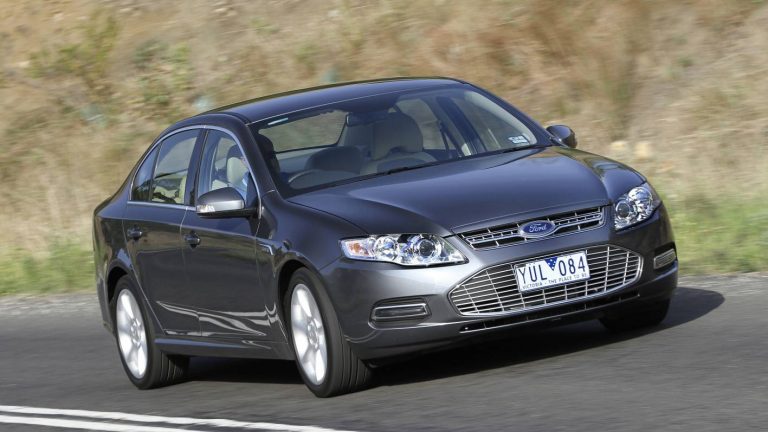[su_image_carousel source=”media: 51636,51637,51638,51639,51627,51628,51629,51630,51631,51632,51633,51634,51635″]
Introduction
Manufactured in Valencia, Spain, Ford’s 2.0-litre turbocharged ‘EcoBoost’ four-cylinder petrol engine was first introduced in Australia 2011 in the Ford MC Mondeo. The 2.0-litre EcoBoost engine was offered in a range of power outputs, with a higher-output, 179 kW version offered in the Ford FG Falcon from 2012 (see table below). Key features for the EcoBoost engine included:
- An aluminium alloy block and cylinder head;
- Double overhead camshafts with Ford’s ‘Twin Independent Variable Cam Timing’;
A BorgWarner K03 low-inertia turbocharger; - For the Mk.4 Mondeo and Mk.5 Mondeo, a compression ratio of 10.0:1; and,
- For the Ford LW/LZ Focus ST and FG Falcon, a compression ratio of 9.3:1.
Please note that this article only considers the 2.0-litre EcoBoost as it was offered in the Ford Mondeo, Ford FG and FG X Falcon and Ford C346ST Focus ST (see table below).
[su_table responsive=”yes”]
| Model | Engine | Trans. | Peak power | Peak torque | Years |
|---|---|---|---|---|---|
| Ford MC Mondeo | 2.0-litre turbo petrol I4 | 6spDCT | 149kW at 6000rpm | 300Nm at 1750-4500rpm (320Nm o’boost) |
2011-14 |
| Ford LW/LZ Focus ST | 2.0-litre turbo petrol I4 | 6sp man. | 184kW at 5500rpm | 340Nm at 2000-4500rpm (360Nm o’boost) |
2012-on |
| Ford FG.II Falcon EcoBoost | 2.0-litre turbo petrol I4 | 6sp auto | 179kW at 5500rpm | 353Nm at 2000rpm | 2012-14 |
| Ford FG X Falcon EcoBoost | 2.0-litre turbo petrol I4 | 6sp auto | 176kW at 5500rpm | 353Nm at 2000rpm | 2014-16 |
| Ford Mk.5 Mondeo | 2.0-litre turbo petrol I4 | 6sp auto | 149kW at 6000rpm | 300Nm at 1750-4500rpm (320Nm o’boost) |
2015-on |
| 177kW at 6000rpm | 340Nm at 2300-4800rpm (360Nm o’boost) |
[/su_table]
EcoBoost block
The EcoBoost engine had a high pressure, die-cast aluminium alloy cylinder block with a ladder-type, cast-aluminium bedplate. Furthermore, the block was an open-deck type and had high strength steel sleeves. With its 87.5 mm bores and 83.1 mm stroke, the EcoBoost engine had a capacity of 1999 cc.
The cylinder block contained balancer shafts that rotated at twice the speed of the crankshaft to offset the secondary inertia force of the rotating system.
Crankshaft, connecting rods and pistons
The 2.0-litre EcoBoost engine had a cast iron crankshaft with 47 mm diameter crankpins, eight counterweights, five 52 mm diameter main bearings and a damped front pulley. Attached to the crankshaft, the EcoBoost engine had drop forged and fractured connecting rods.
The die-cast pistons had a bowl-shaped crown for efficient combustion and a low-friction coating on the piston skirt to reduce wear and friction on the cylinder walls. The pistons featured two steel cast-in upper ring supports. Previously found on high output diesel engines, these steel supports were recessed below the piston top and acted as the upper ringlands; they provided rigidity across the piston and allowed the low tension rings to handle long-term turbo boost. For cooling, oil jets sprayed the underside of the pistons.
Cylinder head and camshafts
The Ford EcoBoost engine had a gravity die-cast aluminium alloy cylinder head with sintered valve guides and seats. Furthermore, the double overhead camshafts (DOHC) were driven by a single, ‘silent’ chain drive.
The EcoBoost engine was fitted with Ford’s ‘Twin Independent Variable Cam Timing’ (Ti-VCT) which used vane-type actuators – controlled by oil pressure – to vary the intake and exhaust camshafts independently and by up to 50 degrees relative to crank angle.
Borg Warner K03 Turbocharger
The 2.0-litre EcoBoost engine had a Borg Warner K03 low-inertia turbocharger. Boost pressures for the Ford Mondeo have published by Ford.
For the Ford FG and FG X Falcon, however, peak boost pressure was 0.9 bar (13 psi). According to Ford, maximum turbocharger speed was 200,000 rpm and it was ‘designed for a lifecycle of more than 200,000 kilometres or 10 years.’
For the Ford LW/LZ Focus ST, peak boost pressure was 1.34 bar (19.5 psi), though a ‘transient overboost’ mode could increase turbine speed for up to 15 seconds at a time – increasing boost pressure to 1.45 bar (21 psi) – for peak torque of 360 Nm from 3000 to 4500 rpm.
Valves
The 2.0-litre EcoBoost engine had four valves per cylinder that were actuated by direct-acting shimless mechanical tappets; to reduce friction, the surfaces of the tappets were polished. The intake and exhaust valves were positioned such that they had a 39 degree included valve angle. Key valve specifications for the EcoBoost engine are as follows:
- 32. 5 mm diameter intake valves;
- 28.0 mm diameter intake valves;
- 7.9 mm intake valve lift; and,
- 6.9 mm exhaust valve lift.
Injection and ignition
For the 2.0-litre EcoBoost engine, the stainless steel fuel rail was mounted directly to the cylinder head and the high-pressure fuel pump was driven by the exhaust camshafts with three lobes and a flat tappet. The EcoBoost engine had seven-hole injectors which injected fuel directly into the combustion chamber at a pressure of 150 bar. To mitigate injector noise, damping material was positioned between the injectors and the cylinder head. The injection and firing order for the EcoBoost engine was 1-3-4-2.
While the 2.0-litre EcoBoost engines for the Ford MC and MD Mondeo had compression ratios of 10.0:1, the Focus ST and Ford FG/Ford FG X Falcon had compression ratios of 9.3:1.
Auto Start-Stop: LZ Focus ST
Produced from late 2014, the Focus LZ Focus ST had an ‘Auto Start-Stop’ function which enabled the engine to shut down when the vehicle was stationary in traffic. The LZ Focus ST was also compliant with Euro VI emissions standards.



